A brief guide to Witchcrafters. I’ve updated it now that they’re out in the TCG!
The basic concept for the archtype is Atelier-themed Spellcaster Craftswomen who discard spells to summon their comrades. Said Spells recur back to the hand later to be used as fuel for the powerful effect(s) of the boss monster(s) you summon. I’ll start with the theme’s monsters, then Spells, and finally close out with the decklists I’ve tested, along with some tech choices.
Witchcraft Basics
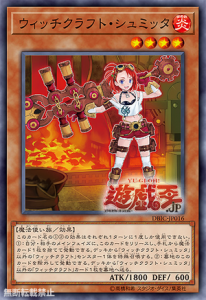 The Level 4 and lower monsters all share a Quick-Effect that discards a Spell to Summon a different Witchcraft from the deck during the Main Phase, and then they have a unique effect you can use from the graveyard to keep things going. With no level restriction, you’ll typically go straight for one of the cast’s boss monsters, who discard Spells for more powerful and disruptive effects. The Witchcrafter Spells will add themselves back to your hand at the End Phase to compensate for this provided you meet their conditions.
The Level 4 and lower monsters all share a Quick-Effect that discards a Spell to Summon a different Witchcraft from the deck during the Main Phase, and then they have a unique effect you can use from the graveyard to keep things going. With no level restriction, you’ll typically go straight for one of the cast’s boss monsters, who discard Spells for more powerful and disruptive effects. The Witchcrafter Spells will add themselves back to your hand at the End Phase to compensate for this provided you meet their conditions.
Of the lower leveled craftswomen, Witchcrafter Schmietta is the standout since her unique effect sends any Witchcraft card to the grave for you to soon recover. Witchcrafter Pitorre comes in a not too distant second since her effect can draw, then discard any Witchcraft card, which will free any boss monster stuck in the hand. Depending on the amount of Spells you have to work with, having Pitorre and Schmietta search each other out before bringing out your boss monster can help maximize on the amount of Witchcraft cards you can put into play.
Witchcrafter Poterie is cute as a button but her unique effect can only be used if your hand is empty, so she doesn’t shine early on. Adding any Witchcraft card (usually a spell) back to the hand is nice since it allows you to use more of your monster effects while bypassing the spell’s restrictions, but it’s still rather situational.
Witchcraft Masters
Witchcrafter Master Verre comes with the ability to negate a whole field of monster effects for a turn while also being able to boost any Spellcaster’s stats when they battle. With these effects combined, she can (smugly) put monsters like the Borreload Dragons in their place. That said, it’s not difficult to overwhelm her with more effects than she can handle, since she can only cast her negate once a turn. She discards a Spell to use it so that’s less for her to reveal when she wants to cast her ATK/DEF buff. For a bit more precision and control, she appreciates being paired with the theme’s other boss monster, Witchcrafter Haine. Haine comes with targeting protection for other Spellcasters, but more importantly, she can destroy any card in play by discarding a Spell during either player’s turn. She can hit Continuous Spells/Traps and stop ignition effects before they can be used, plus she already has a respectable attack stat, and forms a soft lock with another copy of herself in play. She pairs with Verre so well that it’s hard to imagine their character interactions as anything but the easygoing boss supported by the more diligent assistant, but I digress.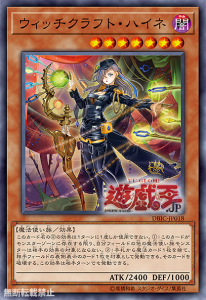
The last Witchcrafter monster is something of an odd one out, or middle manager. Witchcrafter Edel aims to put both Verre and Haine in play at once. She discards a Spell to Summon a witch from your hand, and tributes herself to bring another out from the grave. This is fine and dandy but being level 5 means that she herself is going to end up stuck in your hand at times, much to her embarrassment. Running a copy may be fine but personally I’d make do with using Pitorre to solve the “drawing your boss” problem. Besides, the theme is able to put both Verre and Haine in play at once without her.
Witchcrafting Spellcasting
During the End Phase, you can get back your Witchcrafter Spells from the graveyard, provided you control a Witchcraft monster and haven’t played another copy of that card already that turn. This way your Spells will always have a use so long as you’ve a monster to use them, however it makes the theme very reliant on being somewhat “pure” and keeps them rather balanced, at least early on in the game. Since you can only get either the recursion effect or the activated effect of these spells per turn, the more unique spells you use, the more resources that will flow back to you.
Witchcrafter Creation lets you grab any Witchcraft monster you need, which will usually be Schmietta. The perfect follow up to that is Witchcrafter Holiday which revives any Witchcraft, such as the one you buried with Schmietta. Opening these two cards should net you a Verre and Haine combo easily.
Once you’ve got a boss in play, you can have it attack twice with Witchcrafter Collaboration, which is helpful since the theme doesn’t tend to swarm the field. It also has some protection against Spells/Traps tacked onto it, but to deal with those more directly, Witchcrafter Draping will blow a number of them back to the opponent’s hand for each Witchcrafter monster you’ve got out. Neither of these are overtly amazing but their ease of access due to their recursion effects makes them worth having in your back pocket.
The Continuous Spells are the most interesting of the bunch, since unlike the other Spells, sending these to the graveyard will put them into play during the End Phase. On top of this, you can substitute the cards on the field for the discard costs of your monsters, so it’s almost like you get both effects at once. Depending on what your hand looks like, you’ll frequently use Schmietta to access one of these early on. The first and most important one would be Witchcrafter Bystreet. Bystreet protects your Witchcrafters from being destroyed once a turn each, which is nice when those monsters are Verre and Haine. Witchcraft Scrolls lets you draw once a turn when a Spellcaster beats a monster in battle. Not as high priority as Bystreet, but since you can’t recur two Bystreets at once, Scrolls can be a decent enough option.
Finally, we have Witchcrafter Masterpiece, the lone Trap of the theme, which seems to be designed to set up the 1st effect of your low level Witchcrafters. First it adds another copy of a Spell in any graveyard
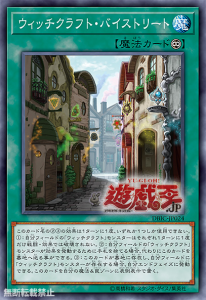
from your deck to your hand, then (next turn) you can banish Masterpiece and a number of Spells from the grave to bring out a Witchcraft whose level matches that number of Spells. Depending on how fast you were able to load your grave with spells, you could go straight for a boss monster or have a lower level Witchcraft set up for it. It’s rather roundabout but this way you can search and activate a spell instead of using it as fodder. It’s an interesting card to say the least but like Poterie, and Edel, it seems rather situational.
Deck Crafting (Here’s the Official Card Database to look up other cards’ details)
The Suggested Konami Decklist that was featured when the theme was fully revealed (Found here at the bottom) is a nice starting point to work from. Since you can get access to both Verre and Haine in as early as the first Schmietta you play, you don’t really need 9 Normal Summons, so I cut down that number among some other “obligatory” inclusions Konami made in their list. You can always add a copy of whatever I cut out if you really want to though. For this theme, it doesn’t hurt that much to play what you like.
The “Magician” Continuous Spells are honestly great inclusions for this deck. Aside from the obvious floating and negation effects, Magician’s Restage also revives a level 3 Spellcaster, which can come in clutch since you need to control a Witchcrafter monster if you want your Spells to come back in the End Phase. You can use your lower level monsters to summon a boss monster even on your opponent’s turn, so Restage can be an important tool to play around interference from your opponent. Called by the Grave and Psy-Frame Gamma are also useful and more direct ways to protect against disruption. Adding in a few generically good Spells and that rounds out the Main Deck. Cards like Reasoning and Card Destruction can help lead to some awesome returns on any Witchcraft Spells they send to the grave, just be careful since the prior could help the opponent and the later could hit a Psy-Frame. Upstart Goblin etc. can be used in place of Pot of Extravagance for those on a budget like me…
Witchcrafter – Simple and Clean Version 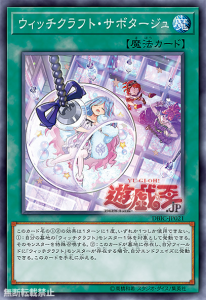
12 Monsters
3 Witchcrafter Schmitta
3 Witchcrafter Pitorre
1 Witchcrafter Haine
1 Witchcrafter Madame Verre
3 Psy-Frame Gamma
1 Psy-Frame Driver
28 Spells
3 Witchcrafter Creation
3 Witchcrafter Sabotage
1 Witchcrafter Collaboration
1 Witchcrafter Draping
1 Witchcrafter Bystreet
1 Witchcrafter Scroll
3 Magician’s Restage
1 Magician’s Right Hand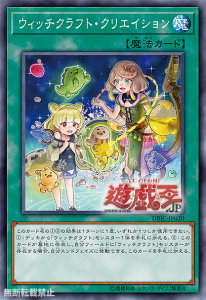
1 Magician’s Left Hand
2-3 Pot of Extravagance
3 Called by the Grave
2-3 Foolish Burial Goods
1 Foolish Burial
0-1 Reasoning
0-1 Upstart Goblin
0-1 Card Destruction
0-1 Metalfoes Fusion
0-1 Monster Reborn
0-3 Into the Void
0-1 One Day of Peace
It’s generally best to avoid adding in Traps unless your meta absolutely requires them, and even then try to keep those to the side deck. Speaking of which, it’s an all-Spellcaster deck, so Secret Village of the Spellcasters and Rivalry of the Warlords are notable disruptive cards at your disposal. As for the Extra Deck, you will rarely access it, so it can be filled with generic cards and cards to use with Ghost Reaper & Winter Cherries and Psy-Framelord Omega.
The first challenge the theme faces would be drawing you cards in the right order, which is fortunately not that hard between full sets of Schmitta, Pittore, and Witchcraft Creation. Ideally you don’t open with Verre or Haine in your hand, but if you do, hopefully you have Pitorre ready to help put them in the grave to summon with Sabotage. While having Verre, Haine, and Bystreet out all at once is ideal, be careful not to commit more Witchcraft monsters to the field than you have spells you are prepared to discard for. When choosing between the three going first, Haine’s effect is useful for offensive and defensive plays, so having her early is probably your best bet. The theme will struggle going second due to how crippling it can be to have your summons stopped (and even going first due to various hand traps), which doesn’t put it in the strongest of positions competitively speaking.
That being said, the potential is there for things to really snowball against the opponent the longer the game goes on, with Verre and Haine constantly suppressing the opponent backed by constantly recurring resources. It’s normally rather difficult to recommend cards that purely stall out the opponent but spells like One Day of Peace could be useful in giving you the time you need to hold off an opponent long enough for things to get rolling in your favor. Alternatively Into the Void can help speed things up with minimal drawbacks since you can add all your Witchcraft spells to your hand after you apply the discard in the End Phase.
All in all, I look forward to seeing the theme evolve and potentially getting even more support in the future. The theme is conspicuously missing a Level 6/WIND monster, who would surely come with her own Witchcraft spell, and we can only wonder about how that Masterpiece they’re making turns out. I look forward to playing with this theme when they come out, and I hope after reading this, you do too.
Bonus Decklists
Here are some of the other things I tried out. I think these are generally less flexible than what I’ve posted above, however the gains from their strengths might be enough to carry things out overall. However you go about it, I hope you enjoy this theme for what it is…even as a certain other Spellcaster theme crashes the party.
Witchcrafter – Spellbook Version (Database)
8-10 Monsters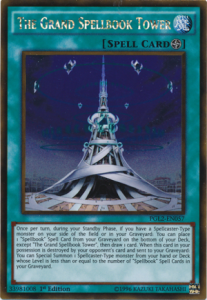
3 Witchcrafter Schmietta
3 Witchcrafter Pitorre
1 Witchcrafter Haine
1 Witchcrafter Master Verre
0-2 Spellbook Magician of Prophecy
30-32 Spells
3 Witchcrafter Creation
3 Witchcrafter Holiday
1 Witchcrafter Collaboration
1 Witchcrafter Draping
1 Witchcrafter Bystreet
1 Witchcrafter Scroll
3 Spellbook of Secrets
2 Spellbook of the Master
2-3 Spellbook of Knowledge
1-2 Spellbook of Eternity
2 Spellbook of Fate
1-3 The Grand Spellbook Tower
0-1 Spellbook of Power
0-1 Spellbook of Wisdom
3 Magician’s Restage
1 Magician’s Right Hand
1 Magician’s Left Hand
3 Called by the Grave
This build sacrifices the extra protection from Psy-Frame Gamma and the usefulness of other generic Spells in favor of the perks of the Spellbook suite. Spellbook of Fate is a very strong card, made all the more threatening when the Spellcaster in front of it is as imposing (smug) as Haine (Madame Verre). Spellbook Tower is also fantastic in a grind game. The main drawback here is that Spellbooks get most of their use from, well, actually being played, so figuring out when to pitch them to cast your Witchcraft effects might take some getting used to. However, since the number of Witchcrafter Spells hasn’t actually changed, it shouldn’t be too different than dealing with other Spells in other variants. At first I was concerned about how well Knowledge would interact with the deck, but thanks to Witchcrafter Sabotage and getting the graveyard effects of your monsters, it’s not as awkward as I thought. You might give up access to having Verre and Haine at once if you send a monster, but even then, the extra draw power can be worth it, especially if you get access to Spellbook of Fate.
Witchcrafter – Bamboo Sword Version (Database)
8 Monsters
3 Witchcrafter Schmietta 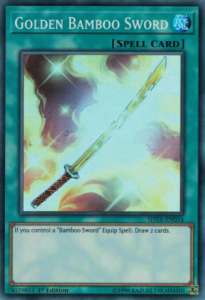
3 Witchcrafter Pitorre
1 Witchcrafter Haine
1 Witchcraft Madame Verre
32 Spells
3 Witchcrafter Creation
3 Witchcrafter Holiday
1 Witchcrafter Collaboration
1 Witchcrafter Draping
1 Witchcrafter Bystreet
1 Witchcrafter Scroll
3 Magician’s Restage
1 Magician’s Right Hand
1 Magician’s Left Hand
3 Pot of Extravegance
3 Called by the Grave
3 Golden Bamboo Sword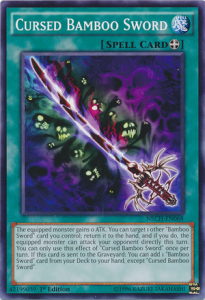
3 Cursed Bamboo Sword
1 Broken Bamboo Sword
0-3 Foolish Burial Goods
0-1 Foolish Burial
0-1 Metalfoes Fusion
0-1 Monster Reborn
0-1 Upstart Goblin
0-1 Card Destruction
0-1 Reasoning
0-3 Into the Void
0-1 One Day of Peace
Technically this version really isn’t all that different than the first build, but adding the Bamboo Sword cards will make less room for various generic cards in exchange for some possibly explosive draws, while also packing more synergistic floating on the part of Cursed Bamboo Sword. You could also theoretically fit Psy-Frame Gamma and Driver here if you want to forgo all the listed generic Spells if you’d like to get back that extra defense.
With all that said, at the end of the day, its up to you to find out how you like to enjoy this theme, but I hope you found this article useful. Please let me know how I did over on our Facebook and Twitter pages, and feel free to bring up anything you think I missed. Thanks for reading!

